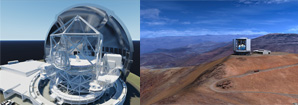GMT, TMT, NOAO, and NSF Team Up on Next Generation of Telescopes

On Monday, May 21, 2018, it was announced that the GMT project, the Thirty Meter International Observatory, and NOAO and the NSF have joined forces. HERE is the press release from NOAO from which we quote a few paragraphs (the photos come from TMT and GMT websites):
"Our shared mission is to strengthen scientific leadership by the U.S. community-at-large through access to extremely large telescopes in the Northern and Southern Hemispheres. This two-hemisphere model will provide the U.S. science community with greater and more diverse research opportunities than can be achieved with a single telescope, and hence more opportunities for leadership.
Our immediate task is advocacy for frontier research programs led by U.S community scientists that can achieve exceptional advancements in humanity’s understanding of the cosmos.
Our audience is the U.S. research community as represented by the upcoming Decadal Survey of Astronomy and Astrophysics (an enterprise of the U.S. National Academies).
As an essential part of that immediate task, we will work with the U.S. research community to develop exemplar Key Science Programs (KSPs) within major research areas including the dark universe, first stars & first galaxies, exoplanet atmospheres, the surfaces of satellites and other small bodies throughout Solar System, and/or other topics to be proposed and prioritized by community-based working groups.
Key Science Programs are envisioned to be open collaborations that gather observers, theorists, and data scientists together to exploit significant investments of Thirty Meter Telescope (TMT) and Giant Magellan Telescope (GMT) observing time, from tens to hundreds of nights. Some of these collaborations are expected to be international in nature. If well-justified by KSP plans, we envisage that at least 25% of the observing time at each international observatory will be available for the U.S. community."

For Public
Public events include our Monday Night Lecture Series, world-reknowned Astronomy Camp and Mt Lemmon Sky Center.

For Students
A good place to start if you want to become an undergrad major or grad student, or need to find our schedule of classes.

For Scientists
Find telescopes and instruments, telescope time applications, staff and mountain contacts, and faculty and staff scientific interests.




